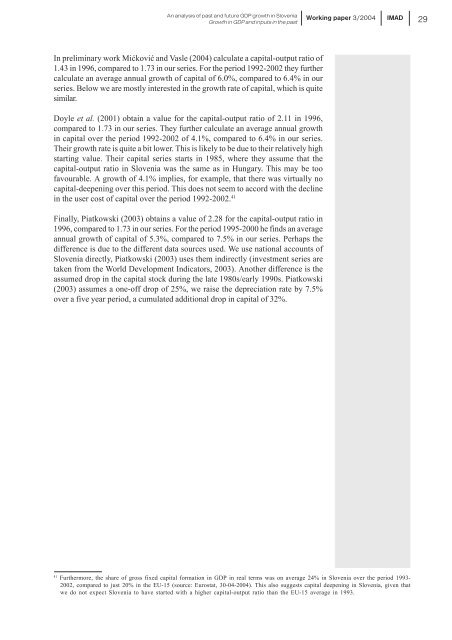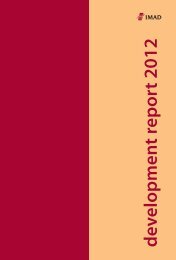Working papers published by IMAD ISSN: 1318-1920 ... - UMAR
Working papers published by IMAD ISSN: 1318-1920 ... - UMAR
Working papers published by IMAD ISSN: 1318-1920 ... - UMAR
You also want an ePaper? Increase the reach of your titles
YUMPU automatically turns print PDFs into web optimized ePapers that Google loves.
An analysis of past and future GDP growth in Slovenia<br />
Growth in GDP and inputs in the past<br />
<strong>Working</strong> paper 3/2004<br />
<strong>IMAD</strong><br />
29<br />
In preliminary work Miækoviæ and Vasle (2004) calculate a capital-output ratio of<br />
1.43 in 1996, compared to 1.73 in our series. For the period 1992-2002 they further<br />
calculate an average annual growth of capital of 6.0%, compared to 6.4% in our<br />
series. Below we are mostly interested in the growth rate of capital, which is quite<br />
similar.<br />
Doyle et al. (2001) obtain a value for the capital-output ratio of 2.11 in 1996,<br />
compared to 1.73 in our series. They further calculate an average annual growth<br />
in capital over the period 1992-2002 of 4.1%, compared to 6.4% in our series.<br />
Their growth rate is quite a bit lower. This is likely to be due to their relatively high<br />
starting value. Their capital series starts in 1985, where they assume that the<br />
capital-output ratio in Slovenia was the same as in Hungary. This may be too<br />
favourable. A growth of 4.1% implies, for example, that there was virtually no<br />
capital-deepening over this period. This does not seem to accord with the decline<br />
in the user cost of capital over the period 1992-2002. 41<br />
Finally, Piatkowski (2003) obtains a value of 2.28 for the capital-output ratio in<br />
1996, compared to 1.73 in our series. For the period 1995-2000 he finds an average<br />
annual growth of capital of 5.3%, compared to 7.5% in our series. Perhaps the<br />
difference is due to the different data sources used. We use national accounts of<br />
Slovenia directly, Piatkowski (2003) uses them indirectly (investment series are<br />
taken from the World Development Indicators, 2003). Another difference is the<br />
assumed drop in the capital stock during the late 1980s/early 1990s. Piatkowski<br />
(2003) assumes a one-off drop of 25%, we raise the depreciation rate <strong>by</strong> 7.5%<br />
over a five year period, a cumulated additional drop in capital of 32%.<br />
41<br />
Furthermore, the share of gross fixed capital formation in GDP in real terms was on average 24% in Slovenia over the period 1993-<br />
2002, compared to just 20% in the EU-15 (source: Eurostat, 30-04-2004). This also suggests capital deepening in Slovenia, given that<br />
we do not expect Slovenia to have started with a higher capital-output ratio than the EU-15 average in 1993.
















